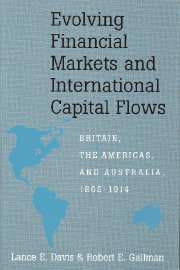 Evolving Financial Markets and International Capital Flows
Evolving Financial Markets and International Capital Flows Book contents
- Frontmatter
- Contents
- 1 Institutional invention and innovation: Foreign capital transfers and the evolution of the domestic capital markets in four frontier countries: Argentina, Australia, Canada, and the United States, 1865–1914
- 2 The United Kingdom
- 3 International capital movements, domestic capital markets, and American economic growth, 1865–1914
- 4 Domestic savings, international capital flows, and the evolution of domestic capital markets: The Canadian experience
- 5 Domestic saving, international capital flows, and the evolution of domestic capital markets: The Australian experience
- 6 Argentine savings, investment, and economic growth before World War I
- 7 Lessons from the past: International financial flows and the evolution of capital markets, Britain and Argentina, Australia, Canada, and the United States before World War I
- 8 Skipping ahead: The evolution of the world's finance markets 1914–1990 – A brief sketch
- 9 Lessons from the past
- Bibliography
- Index
3 - International capital movements, domestic capital markets, and American economic growth, 1865–1914
Published online by Cambridge University Press: 18 August 2009
- Frontmatter
- Contents
- 1 Institutional invention and innovation: Foreign capital transfers and the evolution of the domestic capital markets in four frontier countries: Argentina, Australia, Canada, and the United States, 1865–1914
- 2 The United Kingdom
- 3 International capital movements, domestic capital markets, and American economic growth, 1865–1914
- 4 Domestic savings, international capital flows, and the evolution of domestic capital markets: The Canadian experience
- 5 Domestic saving, international capital flows, and the evolution of domestic capital markets: The Australian experience
- 6 Argentine savings, investment, and economic growth before World War I
- 7 Lessons from the past: International financial flows and the evolution of capital markets, Britain and Argentina, Australia, Canada, and the United States before World War I
- 8 Skipping ahead: The evolution of the world's finance markets 1914–1990 – A brief sketch
- 9 Lessons from the past
- Bibliography
- Index
Summary
Introduction
Of the four frontier countries, the United States depended least on foreign capital. Although as late as the mid-1890s the annual net change in claims on foreigners was typically negative – on balance, foreigners were lending to the United States or acquiring American assets – the story had begun to change; the country was gradually becoming a creditor nation (Table 3:1-1). From 1897 until 1905 the United States, on net, exported capital in every year, and capital exports over the nine years totaled more than $1.5 billion. Over the years 1906 through 1913, however, the country briefly returned to its heretofore traditional role of capital importer. By the standard of these measures, the United States was a very modest net importer of capital in 1906, 1907, and 1909–1913, the inflows in all of these years but one amounting to less than 2 percent of domestic capital formation. Furthermore, even in the years before the mid-1890s, when Americans were frequently experiencing numerically large net capital imports, total foreign holdings of American assets and debts were probably never as large as 10 percent of the American domestic capital stock (Table 3:1-2). Compared with the cases of Australia, Argentina, and Canada, American development was largely a result of internal finance.
Nonetheless, it would be a major mistake to treat the American experience as though it had little relationship to the international capital flows of the nineteenth and early twentieth centuries.
- Type
- Chapter
- Information
- Evolving Financial Markets and International Capital FlowsBritain, the Americas, and Australia, 1865–1914, pp. 234 - 344Publisher: Cambridge University PressPrint publication year: 2001


